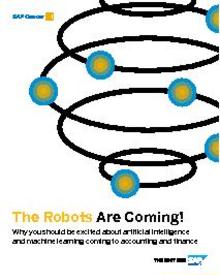What is Cloud ERP, Anyway?
Wondering what cloud ERP is? Well, you've come to the right place. First, let's take a look at a brief history of ERP, and then see how cloud-based ERP is changing business as we know it.
ERP systems in the beginning
What does it take to get companies to update their systems? Sometimes, only the threat of total mayhem. This was certainly the case toward the close of the last millennium, when Y2K, a brand-new flavor of disaster — an IT crisis! — loomed large, kicking off a panicky, worldwide effort to avert computer Armageddon come midnight on January 1, 2000.
Fortunately, the IT crisis never materialized, but the upheaval in the run-up to Y2K did come with a silver lining. It accelerated the adoption of the ERP (enterprise resource planning) systems that help run most large companies today.
An ERP system, at its most basic level, links all of a company’s business processes, from finance to procurement to HR to sales, all sharing a common set of underlying data. The rationale was simple: The better the understanding of how each step in a process affects the next, the more efficient a business can be.
(The term, ‘ERP’ was coined in 1990 by Gartner, the IT consultancy, but its roots date back to the 1960s and 1970s and the first materials requirement planning (MRP) and manufacturing resource planning (MRP II) systems.)
By the time of the Y2K panic in the late 1990s, ERP systems including SAP’s R/3, launched in 1992, were already well established. Nevertheless, concerns about Y2K and its impact on legacy mainframe-based corporate infrastructure fueled a frenzy of IT investment and upgrades.
When all was said and done, U.S. companies had spent $100 billion on Y2K fixes according to a Senate report. But the fixes also presented an opportunity. If companies had to spend piles of money and worker hours on IT overhauls, it only made sense to address bigger IT problems that would end up helping the business in the process.
“Because of Y2K, companies finally said, ‘I guess we have to do this,’” says Dr. Benoit Aubert, professor of information systems and director of the Rowe School of Business at Dalhousie University. “But at the same time, there was enthusiasm for the idea of integration.”
Today ERP systems are part of the mainstream operation of nearly every large company. The market is huge. In 2016, it was worth $25.4 billion in total revenue, according to IDC’s Worldwide ERP Software Tracker, 2017, and projected to grow to $33.6 billion by 2021.
Now another sea change within the ERP market is underway. Large companies are waking up to the advantages of cloud ERP, says Mickey North Rizza, program vice president of enterprise applications and digital commerce at IDC.
From on-premise to the cloud
“Some of these Fortune 500 companies have spent billions of dollars over the last 20 years building, maintaining, upgrading, and customizing ERP products to make them more usable,” North Rizza says, “and what they figured out is that you don’t need to be spending all this money.”
To understand why, consider the differences between on-premise and cloud ERP. Essentially, an on-prem ERP system lives on a company’s own servers, and is customized according to its needs. It’s a system built for a single client, and is typically maintained by the ERP vendor or partners with updates delivered maybe once or twice a year.
In contrast, public cloud ERP systems are standardized to meet the needs of a multitude of clients. Though all the data are separated and secure, the application and intelligence layers are shared, and there’s a common UI. This offers some huge benefits.
First, cloud ERP is typically more affordable. “Management is easier, so those savings are passed along,” says Peter Russo, global vice president, and head of SAP S/4HANA product marketing for SAP. Second, updates are pushed out to everyone at once, which delivers a competitive advantage. You’re not left waiting around for a vendor to update your custom ERP system. Third, if companies identify any issues or unmet needs with cloud ERP, they can push the vendor to deliver changes — the will of the crowd often prevails, Aubert says. Or as Russo put it, with cloud ERP, “the overall pace of innovation is faster.”
Shifting to the cloud also often requires changes to a company’s internal workings, which often turns out to be enormously beneficial. “The beauty of a cloud ERP system is it forces many companies to clean up their data,” Aubert says. Because a cloud ERP system is more standardized, it in turn forces standardization of the underlying data.
That, Aubert says, is simply good for business, because it gets everyone within a company working from a single, unified source of information. It's also crucial if a company wants to take advantage of another big benefit of cloud ERP systems: AI and machine learning.
Letting the machines take over
“We call it intelligent ERP, or iERP; and it’s built in the cloud, because the vendors only want to do this once,” says North Rizza. “You can do it in on-prem, but it’s going to cost you a fortune because you have to keep updating it.”
So, what are the robots up to? Put simply, the machine learning or artificial intelligence that accompanies cloud ERP systems automates common, repetitive tasks. The benefits quickly become clear in finance departments in particular, North Rizza says. “You can do more with less,” she says. She points to one company that, in a recent quarterly earnings call, said it had saved 50% on invoice processing, just by automating the invoice reconciliation with an intelligent process.
And intelligent cloud ERP, coupled with in-memory processing, can handle far more complex situations. “You can detect an error in real time,” says Russo, “and as the algorithms mature, there’s a lot less human intervention needed, and a lot more exception handling.”
Indeed, access to real-time data is an outsize advantage of cloud ERP, and intelligent cloud ERP in particular. Instead of waiting weeks or months to get end-of-quarter results, an executive can run the numbers at any time, and adjust budget or strategy accordingly. Instead of hearing a day too late about a disruption on a production line, a manager can learn about a problem right away, and rest assured that the algorithm has initiated the appropriate solution.
“It’s not only enabling people to pull information from the system,” says Aubert, “but also pushing information out, so people can act more quickly.”
And that can have a meaningful effect on the most important cohort — a company’s customers. Even though cloud ERP should essentially be invisible to customers, “it enables better service, because more and better information is available,” Aubert says. “Customers should just have the impression that the employee serving them is more competent."

